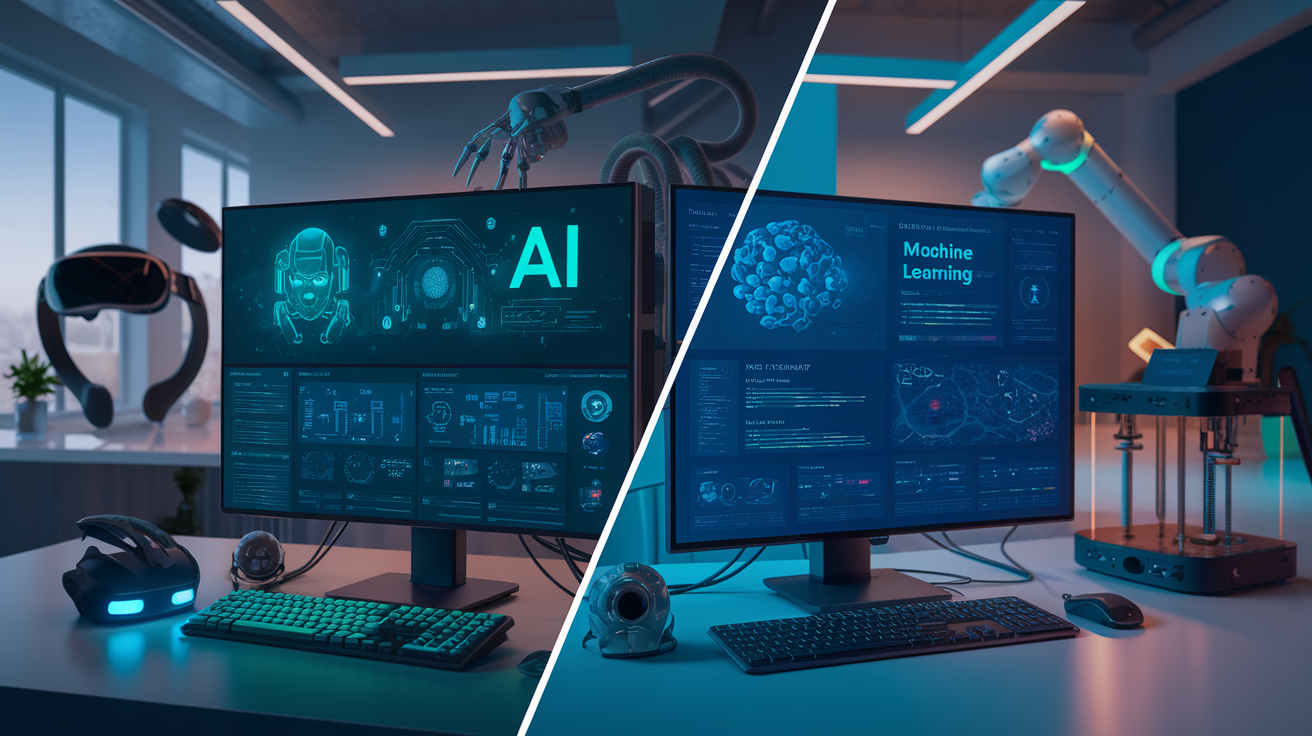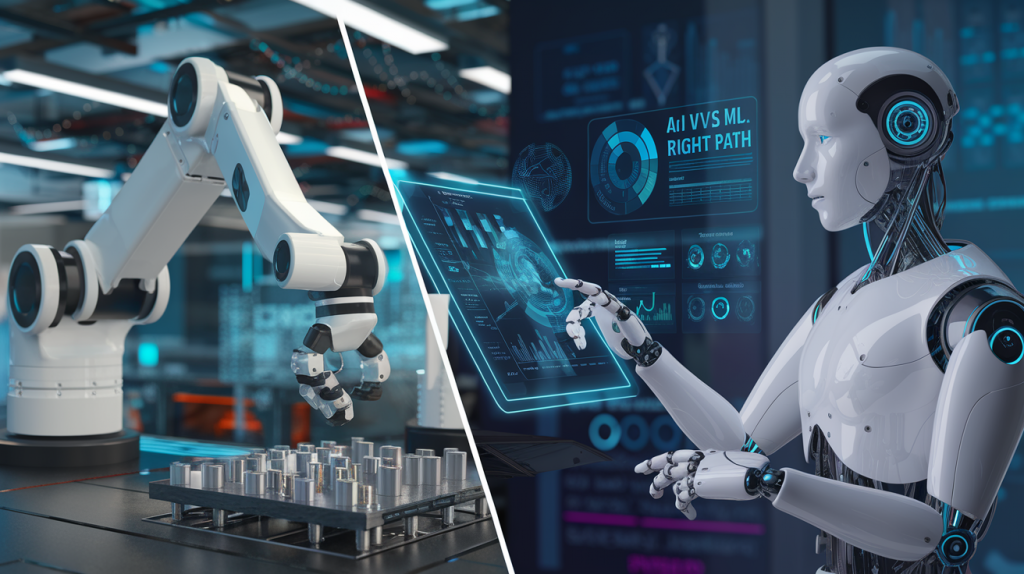Artificial Intelligence (AI) and Machine Learning (ML) have become buzzwords in the business world, promising revolutionary changes and unparalleled growth. But with the rapid advancements in these technologies, many business leaders find themselves at a crossroads: Which should they invest in? 🤔
The global AI market is projected to skyrocket from $136.6 billion in 2022 to a staggering $1.8 trillion by 2030. With such explosive growth on the horizon, it’s crucial for businesses to understand the distinctions between AI and ML, and how they can be leveraged for success. From enhancing medical outcomes in healthcare to driving automation and actionable insights in various industries, these technologies are reshaping the way we work and live.
In this blog post, we’ll dive deep into the world of AI and ML, exploring their real-world applications, market opportunities, and how to choose the right technology for your business. We’ll also discuss the importance of building skills in these fields to stay ahead in an increasingly tech-driven world. Whether you’re a startup founder or a seasoned executive, understanding the power of AI and ML could be the key to unlocking your company’s full potential. 🚀
Understanding AI and Machine Learning

A. Definitions and Differences Explained in Brief
Artificial Intelligence (AI) and Machine Learning (ML) are often confused, but they have distinct characteristics:
- AI: Technology enabling machines to replicate human cognitive functions, including learning, problem-solving, and decision-making.
- ML: A subset of AI focused on enabling systems to learn and adapt autonomously through data-driven algorithms.
Key differences:
| Aspect | AI | ML |
|---|---|---|
| Scope | Broader range of capabilities | Specific focus on learning from data |
| Goal | Mimicking human intelligence | Uncovering patterns in large datasets |
| Application | Voice recognition, natural language understanding | Enhancing task execution through data analysis |
B. Relationship between AI, ML, and deep learning
The relationship between these technologies is interconnected:
- AI encompasses ML as a subset
- ML techniques are integral to advancing AI capabilities
- Deep learning, an advanced ML technique, significantly enhances AI systems
Modern AI systems often rely on ML models for improved functionality, such as adapting to diverse accents in speech recognition.
C. Key capabilities of AI and ML
AI and ML offer several key capabilities for businesses:
- Task automation
- Enhanced decision-making through data analysis
- Personalized customer experiences
- Cost reductions via increased efficiency
- Error minimization
These technologies are crucial for:
- Streamlining operations
- Gaining competitive advantages
- Improving operational efficacy
- Anticipating customer behaviors
In the context of digital transformation, both AI and ML aim to build intelligent systems that leverage data and algorithms to automate complex processes.
Now that we have covered the fundamental concepts and capabilities of AI and ML, we’ll explore their Real-world Applications in various industries, demonstrating how these technologies are transforming businesses across sectors.
Real-world Applications

Now that we’ve explored the fundamentals of AI and Machine Learning, let’s delve into their real-world applications across various sectors. These technologies are transforming industries and enhancing our daily lives in numerous ways.
A. Everyday use cases
Artificial Intelligence and Machine Learning have become integral parts of our daily routines, often without us even realizing it. Here are some common applications:
- Video recommendations: Platforms like Netflix utilize AI to analyze viewing habits and suggest personalized content.
- Chatbots: Many businesses employ AI-powered chatbots for immediate customer service.
- Virtual assistants: AI drives virtual assistants like Siri and Alexa, helping with tasks and queries.
B. Healthcare applications
The healthcare industry has seen significant advancements through AI and ML integration:
- Diagnostic accuracy: AI enhances the precision of medical diagnoses.
- Personalized treatment plans: Machine Learning algorithms analyze patient data to create tailored treatment strategies.
- Medical data analysis: AI processes vast amounts of medical information to derive insights and improve patient care.
C. Business and supply chain improvements
AI and ML are revolutionizing business operations and supply chain management:
| Application | Description | Benefits |
|---|---|---|
| Predictive maintenance | AI forecasts equipment failures | Reduces downtime and maintenance costs |
| Inventory optimization | ML algorithms predict demand | Improves stock management and reduces waste |
| Process automation | AI streamlines repetitive tasks | Increases efficiency and reduces human error |
These technologies also contribute to:
- Fraud detection in finance
- Personalized marketing strategies
- Enhanced cybersecurity measures
By leveraging AI and ML, businesses can significantly improve their operational efficiency, customer satisfaction, and overall performance. From predictive analytics in supply chain management to AI-driven robots in industrial settings, the applications are vast and continually expanding.
With this comprehensive understanding of real-world applications, we’ll next explore the market growth and opportunities in the AI and ML sectors, highlighting the potential for businesses to capitalize on these transformative technologies.
Market Growth and Opportunities

Now that we’ve explored the real-world applications of AI and ML, let’s delve into the market growth and opportunities these technologies present.
A. Current market size and future projections
The AI and ML market is experiencing explosive growth, with projections indicating a compound annual growth rate (CAGR) of 36.2% from 2023 to 2030. This rapid expansion is driven by increased adoption across various industries, particularly in response to global challenges like the COVID-19 pandemic.
Key market trends include:
- Integration of ML with analytics solutions
- Enhanced retail analytics
- Improved security analytics to combat cyber threats
B. Potential impact on various industries
AI and ML are set to revolutionize multiple sectors, with healthcare leading the charge. The impact extends to:
| Industry | AI/ML Applications |
|---|---|
| Healthcare | Diagnosis of complex conditions, genomics research |
| Retail | Hyper-personalization, inventory management |
| Finance | Fraud detection, risk assessment |
| Automotive | Autonomous vehicles, predictive maintenance |
Large enterprises are currently at the forefront of ML adoption, but small and mid-sized enterprises (SMEs) are expected to see significant growth due to reduced ICT investments.
C. Career prospects in AI and ML
The burgeoning AI and ML market presents numerous career opportunities:
- Data Scientists
- Machine Learning Engineers
- AI Researchers
- NLP Specialists
- Computer Vision Engineers
As organizations increasingly leverage AI and ML to gain competitive advantages, the demand for skilled professionals in these fields is expected to soar. Key players like Microsoft, IBM, and Oracle are continuously innovating, creating new job roles and opportunities in the process.
With this understanding of the market growth and opportunities in AI and ML, we can now move on to the crucial task of choosing between AI and ML for your business. This decision will be pivotal in leveraging these technologies to enhance your operational efficiency and competitive edge.
Choosing Between AI and ML for Your Business

Now that we’ve explored the market growth and opportunities in AI and ML, let’s focus on how to choose between these technologies for your business.
Assessing your business needs and goals
When deciding between AI and ML, it’s crucial to align the technology with your specific business objectives. Consider the following:
- Data-driven decision-making: AI and ML enhance decision-making speed and accuracy by processing large datasets and uncovering trends.
- Automation potential: Evaluate which routine tasks could be automated to improve operational efficiency.
- Competitive advantage: Assess how AI or ML could provide a significant edge in your industry.
Considering the complexity of tasks
The complexity of your business tasks plays a vital role in choosing between AI and ML:
| Task Complexity | Suitable Technology | Examples |
|---|---|---|
| Simple, rule-based | Basic ML algorithms | Inventory management, route optimization |
| Moderate complexity | Advanced ML techniques | Predictive analytics, customer segmentation |
| Highly complex | AI with deep learning | Natural language processing, image recognition |
Evaluating available data and resources
To effectively implement AI or ML, consider your data and resource availability:
- Data quality and quantity: Ensure you have sufficient high-quality data to train models effectively.
- Infrastructure: Assess your current technological infrastructure and its capability to support AI/ML implementation.
- Expertise: Determine if you have the necessary in-house skills or need to hire specialized software developers.
- Budget: Consider the financial investment required for implementation and ongoing maintenance.
Remember that while AI and ML offer powerful capabilities, human expertise remains crucial in interpreting insights and making strategic decisions. As we move forward, we’ll explore how to build the essential skills in AI and ML to ensure successful implementation and maximize the potential of these technologies in your business.
Building Skills in AI and ML

Now that we’ve explored how to choose between AI and ML for your business, let’s dive into the crucial aspect of building skills in these transformative technologies. With the growing demand for professionals versed in AI and ML, it’s essential to understand the educational pathways and key areas of study.
Educational resources and courses
To build skills in AI and ML, professionals can leverage various educational resources:
- University programs: Institutions like MIT offer specialized courses in AI and ML
- Online platforms: Courses focusing on practical AI applications, such as the “AI Skills for Business Professionals” program
- Industry collaborations: Programs like the AI and ML: Leading Business Growth, conducted by MIT faculty with Northwest Executive Education
These resources cater to different levels of expertise, from foundational knowledge to advanced applications.
Key areas of study
When building skills in AI and ML, focus on these critical areas:
- AI fundamentals and GPT models
- Prompt engineering and effective AI tool utilization
- Data analysis and visualization
- API integration and automation
- Business applications of AI and ML
| Area of Study | Importance | Application |
|---|---|---|
| AI fundamentals | Essential base knowledge | Understanding AI capabilities |
| Prompt engineering | Crucial for AI interaction | Crafting effective AI queries |
| Data analysis | Core skill for ML | Extracting insights from data |
| API integration | Advanced application | Automating business processes |
| Business applications | Practical implementation | Solving real-world problems |
Practical experience and hands-on learning
To truly master AI and ML skills, hands-on experience is invaluable:
- Real-world projects: Participate in programs that culminate in practical projects, such as developing AI solutions for business problems
- No-code platforms: Utilize tools like Ikigai to prototype AI ideas without extensive coding knowledge
- Simulations: Engage with AI simulations, like digital twins, to understand complex systems
- Collaborative learning: Form teams to tackle AI challenges, fostering a deeper understanding through peer interaction
- Continuous application: Apply AI concepts in various business contexts to reinforce learning and discover new applications
By combining theoretical knowledge with practical application, professionals can develop the strategic insights and expertise necessary to drive business growth through AI and ML technologies.

As we’ve explored, both AI and machine learning offer powerful solutions for businesses across various industries. From enhancing decision-making processes to optimizing supply chains, these technologies are revolutionizing the way companies operate. The choice between AI and ML depends on your specific business needs, available resources, and long-term goals. Whichever path you choose, the potential for growth and innovation is substantial, with the global AI market projected to reach $1.8 trillion by 2030.
To stay competitive in this rapidly evolving landscape, it’s crucial to invest in building AI and ML skills within your organization. Consider exploring educational opportunities offered by renowned institutions and platforms to equip your team with the necessary knowledge and expertise. By embracing these technologies and continuously adapting to new developments, your business can harness the full potential of AI and machine learning, driving efficiency, innovation, and success in the digital age.
